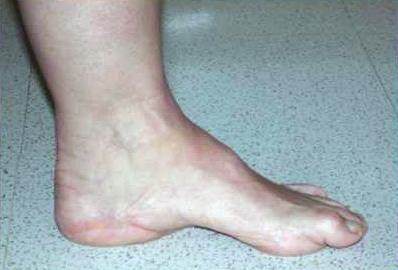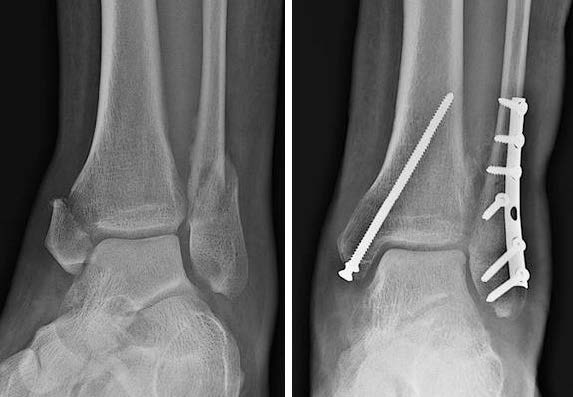The calcaneus is the heel bone. Fractures or breaks of the calcaneus commonly occur after a fall from a height or car accident. Treatment of these fractures may require surgery.
Calcaneus Fracture Surgery
The goal of heel fracture surgery is to restore the shape of the heel bone as close to normal as possible. Restoration of normal alignment and contour is considered the best way to restore function and minimize pain.
Diagnosis
Surgery is recommended when a broken heel bone has lost its alignment and contour. Identification of the fracture typically is made after a physical examination by obtaining standard foot and ankle X-rays. The specific type, pattern and classification of the fracture is best made by obtaining a CT scan. Your surgeon may require both X-rays and a CT scan to determine if surgery is your best option.
Not all heel fractures require surgery. If the shape of the calcaneus is generally maintained, surgery may not be needed. Patients with diabetes may be at increased risk for infection or wound healing problems. Patients with poor blood flow may also have difficulty healing properly. Elderly individuals may have difficulty with surgical rehabilitation.
Heel surgery often is delayed due to the swelling that typically accompanies these injuries. It may be severe enough to delay surgery for weeks or preclude it altogether. Surgery can safely proceed when the skin at the surgical site at the lateral heel wrinkles, indicating the dangerous swelling has gone away.
Medications such as immuno-suppressants or steroids may slow healing and delay or preclude surgery. Smoking is considered harmful for wound and fracture healing and smokers should quit before any planned calcaneus surgery.
Treatment
The most common surgical techniques utilized to treat a broken heel bone involve cutting through the skin to place the bone back together and using plates and screws to hold the alignment until the bones heal. A classic “open” procedure involves an incision over the lateral aspect of the heel. The incision is likened to a hockey stick or large “L” where the overlying nerve and tendons are moved out of the way. The fracture fragments are restored to the best possible position and a plate and screws hold the fragments in place.
The technique of “closed” reduction and percutaneous fixation can sometimes be utilized. Multiple small incisions are placed in critical areas around the heel. The broken fragments can be realigned with the help of X-rays. Screws are then placed through the skin to hold the position.
The size and location of the incision and the type of screws and plates used are based on skin quality and the surgeon’s judgment on how to best access and fix the broken fragments of bone.
Specific Technique
General anesthesia, used to put a patient to sleep during surgery, commonly is used along with a regional nerve block, which involves a local injection to help with pain control. The addition of a regional block can provide 12 to 24 hours of pain control after surgery. Surgery can be a same-day procedure or planned with a hospital stay.
A tourniquet is used to minimize bleeding and to ensure proper visualization of critical structures that are protected during the surgery. For the standard open approach, a hockey stick or “L” incision is made on the outside of the heel. The sural nerve and the peroneal tendons are moved out of the way and the skin is held back by placing wires in key positions. The bony fragments are then visualized. The general alignment of the heel is restored. The fragments are then placed into position.
All fragments are temporarily held in position with small removable wires. The wires are then removed, and a plate and screws are placed. The skin is then closed. Post-surgical dressings and a splint are applied.
Recovery
Expect a lengthy recovery after calcaneus fracture surgery. You will be given a splint or cast. You should not put weight on your foot for at least 6-8 weeks until there is sufficient healing of the fracture. The foot remains very stiff and some permanent loss of motion should be expected. Most patients have at least some residual pain despite complete healing.
Everyone who sustains a malaligned break of the calcaneus, particularly involving the joint, should expect to develop some arthritis despite having surgery. If arthritis pain and dysfunction of the foot become severe, then further surgery may be required. Heel bone fractures often are severe and can be life-changing.
Risks and Complications
All surgeries come with possible complications, including the risks associated with anesthesia, infection, damage to nerves and blood vessels, and bleeding or blood clots.
Complications from treatments for displaced calcaneus fractures can be severe. The most common early complications are in skin healing and nerve stretch. Most wound healing complications can be treated with wound care. Occasionally further surgical treatment may be required. The development of a deep wound infection often requires surgery and antibiotics. Nearly all nerve stretch complications will resolve over time.
FAQs
Do the plates and screws need to be removed?
No, plates and screws do not need to be removed. If they are causing pain or irritation, your surgeon may consider removing them, but he or she will make sure there is enough fracture healing before proceeding.


